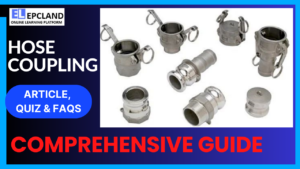Introduction
Stub-in and stub-on connections are two essential techniques used in the piping industry to join pipes securely. In the world of piping systems, efficient and reliable connections are paramount to ensuring the safe and smooth transportation of fluids These methods provide structural integrity, prevent leaks, and facilitate maintenance. In this comprehensive guide, we will delve into the details of stub-in and stub-on connections, exploring their differences, applications, advantages, and key considerations.
Don’t miss the Complete Course on Piping Engineering: Check Now
By EPCLand.com
Table of Contents
Understanding Stub-in Connections
What Are Stub-in Connections? Stub-in connections, also known as branch connections or lateral connections, involve attaching a smaller pipe or branch to a larger main pipe. This technique is widely used when there is a need to divert or branch off from the main pipeline for various purposes, such as distribution, control, or instrumentation.
Key Features of Stub-in Connections:
- Welding: Stub-in connections are often achieved through welding methods, ensuring a secure and leak-proof joint.
- Reduced Stress Concentration: Proper design and implementation of stub-in connections can help distribute stress and minimize concentration points.
- Diverse Applications: These connections find applications in industries like petrochemicals, water treatment, and HVAC systems.
Advantages of Stub-in Connections:
- Space Efficiency: Stub-in connections take up less space compared to some alternatives like threaded connections.
- Smooth Flow Transition: Properly designed stub-ins offer smooth fluid flow transition, minimizing pressure losses.
Key Considerations for Stub-in Connections
When employing stub-in connections, several factors should be considered to ensure optimal performance and longevity.
- Material Compatibility: The material of the stub-in pipe should be compatible with the main pipe material to prevent galvanic corrosion.
- Welding Techniques: Choosing the appropriate welding technique is crucial for a strong and durable joint. Factors like pipe material, thickness, and welder expertise play a role.
- Stress Analysis: Conducting stress analysis helps determine potential stress points and guides the design of the connection to mitigate stress concentration.
- Proper Alignment: Accurate alignment during installation is essential to prevent misalignment-related issues in the future.
- Maintenance Access: Consider accessibility for maintenance and potential future modifications when positioning stub-in connections.
Exploring Stub-on Connections
What Are Stub-on Connections? Stub-on connections, also referred to as saddle connections or saddle taps, involve attaching a saddle-like fitting onto the main pipe to create a branch connection. This technique is commonly used for smaller pipes or temporary connections.
Key Features of Stub-on Connections:
- Easy Installation: Stub-on connections are relatively easier to install compared to some other methods, making them suitable for quick installations.
- Versatile Applications: These connections are often used in irrigation systems, temporary testing setups, and situations where permanent connections are unnecessary.
Advantages of Stub-on Connections:
- Cost-Effectiveness: Stub-on connections are cost-effective due to their simple installation process and reduced material requirements.
- Temporary Solutions: They can serve as temporary solutions or testing points without the need for extensive modifications to the main pipe.
Key Considerations for Stub-on Connections
While stub-on connections offer simplicity, certain considerations must be taken into account for reliable performance.
- Pressure Limitations: Stub-on connections might have pressure limitations compared to more robust connection methods, making them suitable for specific scenarios.
- Leak Potential: Improper installation or poor-quality saddle fittings can lead to leaks, underscoring the importance of quality materials and workmanship.
- Longevity: Stub-on connections might not have the same durability as more permanent solutions, so their lifespan should be evaluated based on the intended use.
Don’t miss the Complete Course on Piping Engineering: Check Now
By EPCLand.com
Differences Between Stub-in and Stub-on Connections
Installation Complexity:
- Stub-in connections typically require more precise welding and alignment, making them more complex to install than stub-on connections.
- Stub-on connections are easier and faster to install due to their saddle-like design.
Applications:
- Stub-in connections are commonly used for permanent branch connections, while stub-on connections are often employed for temporary or testing purposes.
Durability and Longevity:
- Stub-in connections, when properly installed, generally offer greater durability and longevity compared to stub-on connections.
Pressure Handling:
- Stub-in connections are better suited for high-pressure applications due to their welded joints and structural integrity.
- Stub-on connections are ideal for low to moderate pressure scenarios.
Table to summarize differences between stub-in and stub-on connections
Following is the table comparing stub-in and stub-on connections in piping:
| Aspect | Stub-in Connections | Stub-on Connections |
|---|---|---|
| Installation Complexity | More complex due to precise welding and alignment. | Easier and faster installation. |
| Applications | Common for permanent branch connections. | Primarily used for temporary or testing. |
| Durability and Longevity | Generally offer greater durability and longevity. | Often less durable, suited for specific use. |
| Pressure Handling | Suited for high-pressure applications. | Suitable for low to moderate pressure. |
| Retrofit Possibility | Retrofitting may require significant alterations. | Retrofitting might be feasible with caution. |
| Material Compatibility | Compatible with a wide range of materials. | Compatible with various pipe materials. |
| Maintenance | Regular inspections and maintenance essential. | Monitoring for leaks and degradation vital. |
| Cost-effectiveness | May involve higher costs due to welding expertise. | Generally more cost-effective. |
FAQs About Stub-in and Stub-on Connections
FAQ 1: Are Stub-in connections stronger than Stub-on connections? Stub-in connections, due to their welded joints and careful alignment, are usually stronger and more durable than stub-on connections. Stub-on connections are suitable for temporary or low-pressure scenarios.
FAQ 2: Can I retrofit a Stub-on connection into a Stub-in connection later? In some cases, it might be possible to retrofit a stub-on connection with a more robust stub-in connection. However, this process can be complex and may require alterations to the main pipe, making it advisable to plan for the desired connection type from the outset.
FAQ 3: What materials are commonly used for Stub-in and Stub-on connections? Common materials for both connection types include carbon steel, stainless steel, and various alloys, depending on factors like fluid compatibility, pressure, and environmental conditions.
FAQ 4: Can Stub-on connections be used for permanent installations? While stub-on connections are generally intended for temporary or testing purposes, they might be suitable for very specific permanent installations with low-pressure requirements.
FAQ 5: What maintenance practices are essential for ensuring the integrity of these connections? Regular inspections, monitoring for leaks, and addressing any signs of degradation are crucial for maintaining the integrity of both stub-in and stub-on connections. Proper maintenance can extend the lifespan of these connections and prevent costly failures.
Conclusion: In the realm of piping systems, the choice between stub-in and stub-on connections hinges on factors such as intended application, pressure requirements, installation complexity, and long-term durability. Stub-in connections offer robustness and structural integrity for permanent installations, while stub-on connections provide simplicity and versatility for temporary or low-pressure scenarios. By understanding the nuances of these connection methods and adhering to best practices, professionals in the piping industry can ensure reliable, efficient, and leak-free operations within their systems.
Recommended courses (Published on EPCLand)
- Basics of Piping Engineering
- Piping Layout Engineering
- Piping Material Engineering
- Piping Stress Analysis
- Complete Course on Piping Engineering
- Material Requisitions
- Piping Material Specifications
- Valve Material Specifications
Don’t miss the published articles on following:
Related Video
Attempt Quiz
Question 1:
What is a stub-in connection in piping?
Explanation: A stub-in connection in piping refers to a connection where a smaller diameter pipe is inserted into a larger diameter pipe and welded in place to create a branch connection.
Question 2:
What is a stub-on connection in piping?
Explanation: A stub-on connection in piping refers to a connection where a larger diameter pipe is welded onto the exterior of a smaller diameter pipe to create a branch connection.
Question 3:
What is the primary advantage of using stub-in connections?
Explanation: The primary advantage of using stub-in connections is that they are easier to install compared to other types of connections, as they involve welding a smaller pipe into a larger one.
Question 4:
Which type of connection requires the wall thickness of the larger pipe to be increased?
Explanation: The stub-on connection requires the wall thickness of the larger pipe to be increased in order to accommodate the welding process.
Question 5:
What is the purpose of using a stub-in or stub-on connection in piping?
Explanation: The purpose of using a stub-in or stub-on connection in piping is to create branch connections for piping systems, allowing for the attachment of smaller pipes to larger ones while maintaining fluid flow.



